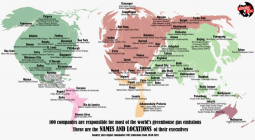Drawdown’s Latest ‘Tools of Possibility’ Show Path to 1.5°C, with 1,570 Billion Tons of Emission Cuts by 2050.

Humanity can prevent or draw down 1,570 billion tons of greenhouse gas emissions between 2020 and 2050 to approach a 1.5°C threshold for average global warming, or 992.77 billion tons to settle around 2.0°C, by adopting a menu of 82 practical solutions ranging from onshore wind to utility-scale solar, from reduced food waste and plant-rich diets to tropical forest restoration and clean cookstoves, according to the 2020 update of the popular Drawdown list.
“Drawdown is a critical turning point for life on Earth, and we must strive to reach it quickly, safely, and equitably,” the authors state. They herald a “future point in time when levels of greenhouse gases in the atmosphere stop climbing and start to steadily decline,” adding that The Drawdown Review represents “an overview of climate solutions in hand—now, today—to reach Drawdown and begin to come back into balance with the planet’s living systems.”
The site adds: “These solutions are tools of possibility in the face of a seemingly impossible challenge. They must not remain the domain of specialists or select groups.”
The Drawdown Review website includes a list of the 82 solutions that make up the two scenarios, individual profiles for each option, and a free download in book form. It updates the group’s initial, landmark publication in 2017, which it says has “influenced university curricula, city climate plans, commitments by businesses, community action, philanthropic strategy, and more.”
The update revolves around three key strategies: bringing emissions to zero, supporting greenhouse gas sinks by “uplifting” nature’s carbon cycle, and improving society by “fostering equality for all”. The solutions themselves fall into nine sectors: electricity (440.2 gigatons in the 1.5°C scenario); food, agriculture, and land use (273.9 Gt); industry (143.8 Gt); transportation (97.4 Gt); buildings (141.2 Gt); land sinks (387.8 Gt); coastal and ocean sinks (1.48 Gt); engineered sinks (4.39 Gt); and health and education (85.42 Gt).
Among the highlights from the 1.5°C scenario in Drawdown’s table of solutions:
- Onshore wind cuts 147.72 billion tons of carbon dioxide or equivalent between 2020 and 2050 at a cost of US$1.66 trillion, but delivers $10.12 trillion in lifetime savings.
- Utility-scale solar photovoltaics cuts 119.13 trillion, actually saves $290 billion during implementation, and delivers further lifetime savings of $26.42 trillion.
- Reducing food waste holds its #3 position from the 2017 Drawdown list, reducing emissions by 94.56 Gt in the 1.5°C scenario.
- Refrigerant management cuts or sequesters the equivalent of 57.75 gigatons of carbon dioxide, at a lifetime cost of $629 billion, with a focus on the short-acting, highly damaging climate pollutants that made refrigerants the first priority in the original Drawdown list. Alternative refrigerants reduce or sequester another 50.53 Gt, at no net cost or saving compared to the sources they replace.
- Indigenous peoples’ forest tenure delivers 12.93 gigatons of carbon reductions.
- For all the storm and fury devoted to carbon capture and storage in research journals and popular media, the only engineered carbon sink that made this year’s Drawdown list is biochar production, with a saving of 4.39 gigatons. The Drawdown team says it plans a closer look at other engineered solutions like direct air capture.
*Title Photo :
Karsten Würth (@inf1783)/wikimedia commons
4 March 2020
The Energy Mix





